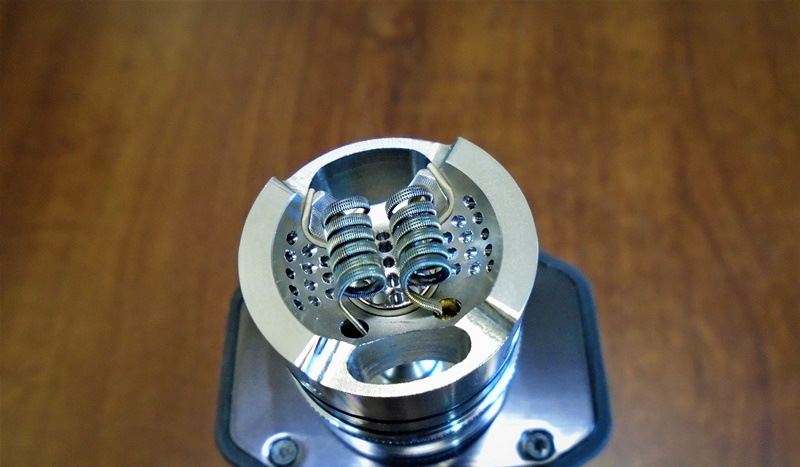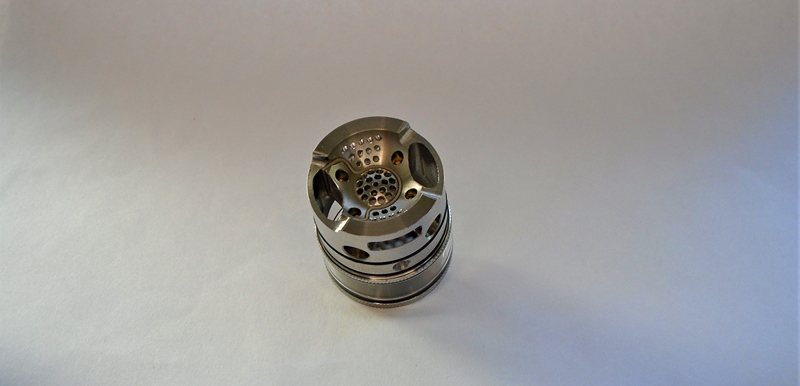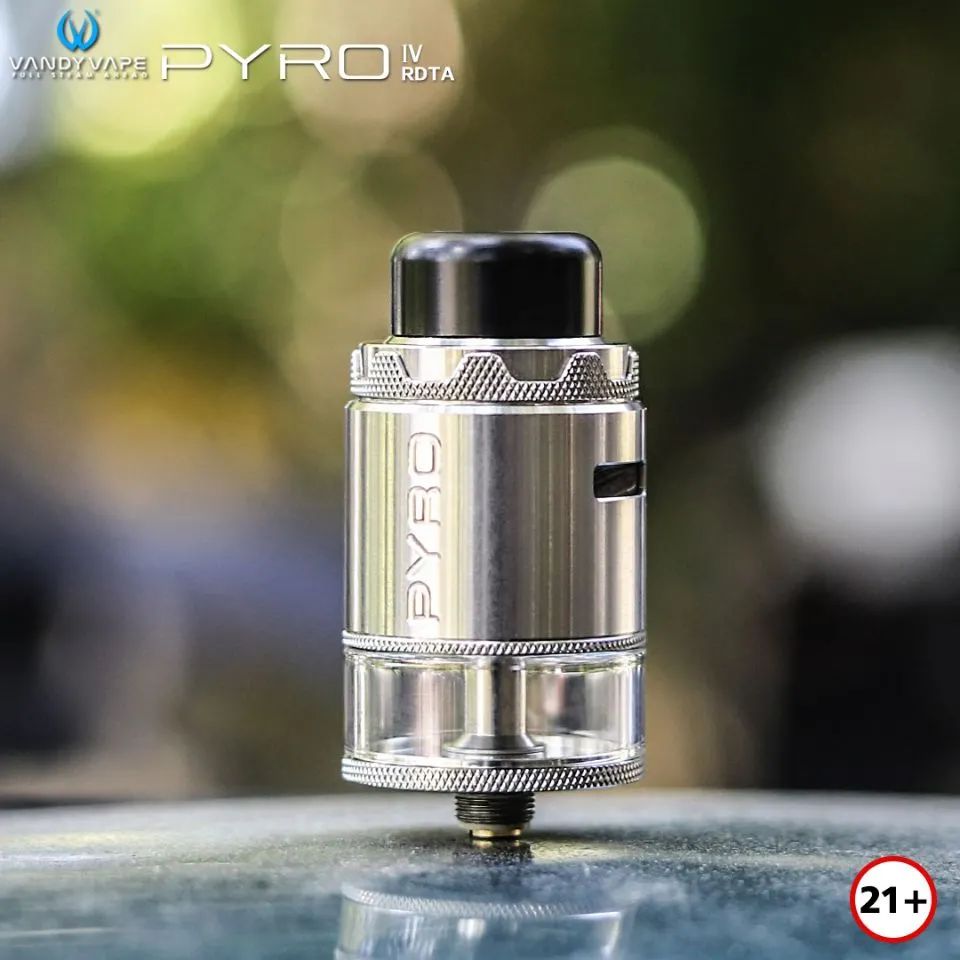
Introduction
RDTAs have become a rarity in the vaping industry, compact RTAs produce comparable flavor, squonk mods give RDAs more juice capacity than most RDTAs could dream of, and top-airflow RTAs are far less prone to leaking.
Fortunately, a few companies such as Steam Crave, Thunderhead Creations and Vandy Vape are still producing them.
For this review, the RDTA in question is the Vandy Vape Pyro V4, a 25.5mm dual-coil RDTA with 5ml juice capacity.

- Pyro V4 RDTA
- 2 × Ni80 tri-core fused claptons
- coil measuring tool
- spare glass
- accessories/spares including 510 drip-tip adapter and squonk pin
Why no cotton? Seriously, a couple of pieces of cotton must cost next to nothing, so why not include it?
First Impressions
From the outside, it’s a very conventional RDTA – side airflow (except it isn’t) no fancy metal wicking, straight glass – if someone had told me it was a five year old design, I would have believed them.
Of course, once you take the top-cap off everything changes. The airflow does come in at the sides, but is directed to a honeycomb half-pipe and an under-coil honeycomb convex center.
The deck is a postless design and the chamber is more compact than you’d initially imagine, mainly due to the size of the half-pipe airflow.
I then started looking for the juice fill-port, there’s a tiny hole on the side underneath the airflow intake slots, but that can’t be it, it’s far too small. Except, that is it – more on that later.
The design is very restrained, the only aesthetic design element is a castle rampart style design that was present on previous versions of the Pyro.

Build
The build gave me two issues:
- I rarely get annoyed with poor quality screws, but these annoyed me. I had to get a better screwdriver, as the regular one (that works on every other atomizer just fine) was starting to strip the head of the screws.
- The post holes were quite far apart for the coils that I was using, however this was solved by spacing the coils, so they could drop into the post holes easily.
One the above issues were resolved, the rest of the build was simple – align the coils with a coiling rod and it’s done.
Wicking any RDTA should be simple, not quite as simple as an RDA, but much easier than most RTAs.
I cut my wicks about 1cm outside of the base and this turned out to be just about as short as you can get away with – 1.5cm on each side should be perfect.
I removed the tank for the wicking, you don’t need to but I wanted a good view of exactly how far the cotton was protruding into the tank. As a general rule as long as your cotton is long enough to enter the tank and not so long that it touches the bottom, you’re going to be good.
The longer your wicks are, the easier it’s going to be to vape when the tank is getting empty, however the shorter the wicks are, the better it’s going to wick as the juice has a shorter distance to travel.

How does it perform?
- 2 × 3.0mm Ni80 tri-core fused claptons – these were the supplied coils and came to 0.22ohms for the pair. At 60w with airflow fully open this build was slightly disappointing in regards to flavor and vapor production. When I pushed it to 70w, it started to come alive with good flavor and vapor production, and at 80w and above it was excellent, the flavor wasn’t as accurate as a single-coil flavor chasing RTA, but flavor strength and the vapor production was very impressive.
While this build was giving me excellent flavor, I wanted something that would perform well with less power.
- 2 × 3.0mm 26g claptons – these came to 0.24ohms for the pair. These coils did allow me to drop the power a little, 60-70w with these coils gave good flavor and vapor production, however it wasn’t as in your face impressive as the first build.
Airflow
With a total of 45 (I think) honeycomb holes, you’d expect the airflow to be smooth and it is.
It’s also comparatively quiet, however closing down the airflow increases the noise a little.
This will be a personal preference, but I enjoyed running this RDTA with airflow fully open.

Juice fill
This worried me, the juice fill port is tiny, I had mental images of me covering everything in juice and nothing getting into the RDTA.
However, despite the narrow hole it works well. My filling technique was to hold the bottle tip firmly in the hole at a 90 degree angle, and squeeze.
So, it does work – however, it doesn’t fill you with confidence, I’m sure there are numerous better fill methods such as silicon membrane or spring-loaded valve that could have been used.
Leaks
This is where every RDTA of mine has let me down. They leak, it’s an unavoidable consequence of the design.
So, I in order to prove this theory to be correct, I put the Pyro on its side on some paper towels with a full tank of juice and then went to make dinner – two hours later, the paper towel was still bone dry.
I’m not about to suggest that this RDTA is leak-proof and suitable for bags or pockets, however it does seem to leak far less than other RDTAs that I’ve used.
What could be improved?
- Better screws please.
- Better juice fill port.
Disclaimer
The Pyro RDTA V4 was provided for the purposes of this review by Healthcabin who currently have it in stock. In addition to catering to end users, HealthCabin is also one of the biggest vape wholesale distributors in China, if you’re a vape business owner, just contact them to get competitive wholesale prices.



This review was written by Owen from Vaping Underground, click to view original review there with more details.



